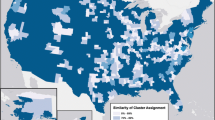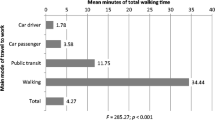Abstract
Recent declines in carpooling among American commuters are analyzed using data derived from the US Census of Population, the Nationwide Personal Transportation Study, and the American Home Survey. The most important factors associated with recent declines in carpooling to and from work in the US include increasing household vehicle availability, falling real marginal fuel costs, and higher average educational attainments among commuters. Age, sex, family income, household lifecycle characteristics, urban form, racial diversity and relative poverty appear to have had smaller effects on observed changes in carpooling for the work trip.
Similar content being viewed by others
References
Brunso J, Kocis M & Ugolik W (1979) Factors Affecting Ridesharing Behavior.Preliminary Research Report 165, New York State Department of Transportation, Albany, New York.
Cervero R & Griesenbeck B (1988) Factors influencing commuting choices in suburban labor markets: a case analysis of Pleasanton, California. Transportation Research A22: 151-161.
Daniels PW (1981) Vehicle sharing for the journey to work by office workers. Transportation Research A15: 391-398.
Dasgupta M, Frost M & Spence N (1985) Interaction between urban form and mode choice for the work journey: Manchester/Sheffield 1971-1981. Regional Studies 19: 315-328.
Davis FW (1975) Ride Sharing and the Knoxville Commuter, final report to the US Department of Transportation, Office of Environmental Affairs, Washington, DC.
Edmondson B & Jacobsen L (1993) The lonely road. American Demographics 79(4): 63.
Edmondson B (1993) Demographics and market definition. Resource Papers for the Symposium on TDM Innovation and Research: Setting a Strategic Agenda for the Future, Washington, DC, November.
Ferguson E (1985) The Benefits and Costs of Ridesharing to Employers.Los Angeles, California: Commuter Transportation Services, Inc.
Ferguson E (1986) A Conceptual Cost Model of Employer-Based Ridesharing Programs. Los Angeles, California: Commuter Transportation Services.
Ferguson E (1990a) An evaluation of employer ridesharing programs in Southern California. Transportation Research Record 1280: 59-72.
Ferguson E (1990b) The influence of employer ridesharing programs on employee mode choice. Transportation 17: 179-207.
Ferguson E (1991a) The influence of household composition on residential location and journey to work in the United States. Presented at the 70th Annual Meeting of the Transportation Research Board, Washington, DC, January.
Ferguson E (1991b) Ridesharing, firm size and urban form. Journal of Planning Education and Research 10(2): 131-141.
Ferguson E (1994) Recent declines in carpooling. 1990 NPTS Draft Special Report, US Department of Transportation, Washington, DC, Volume I, pp. 61-130, April.
Ferguson E (1995) The demographics of carpooling. Transportation Research Record 1496: 142-150.
Gensch DH (1981) A practical segmentation strategy to increase ride sharing. Transportation Research A15: 331-337.
Hanson S & Johnston I (1985) Gender differences in work-trip length: explanations and implications. Urban Geography 6: 193-219.
Hartgen D (1977) Ridesharing Behavior: A Review of Recent Findings. Preliminary Research Report 130, New York State Department of Transportation, Albany, New York.
Hartgen D & Bullard K (1993) What has happened to carpooling: trends in North Carolina, 1980 to 1990. Transportation Research Record 1390: 50-59.
Hoffman CM & Beck RJ (1983) A sensitivity analysis of commuting patterns: an occupational comparison. The Review of Regional Studies 13: 26-30.
Horowitz A & Sheth J (1978) Ride sharing to work: an attitudinal analysis. Transportation Research Record 637: 1-8.
Hu PS and Young J (1992) Summary of Travel Trends: 1990 Nationwide Personal Transportation Survey. Report No. FHWA-PL-92-027, US Department of Transportation, Washington, DC, March.
Lee LW (1984) The economics of carpools. Economic Inquiry 22: 128-135.
Madden JF (1981) Why women work closer to home. Urban Studies 18: 181-194.
Margolin JB, Misch MR & Stahr M (1978) Incentives and disincentives of ridesharing. Transportation Research Record 673: 7-15.
Matthews R (1993) Carpooling trends in Georgia: 1980 to 1990. Unpublished seminar paper, CP 6830, Urban Transportation Planning and Policy Analysis, Graduate City Planning Program, Georgia Institute of Technology, June.
Michaelson W (1985) From Sun to Sun: Daily Obligations and Community Structure in the Lives of Employed Women and their Families. New Jersey: Rowman & Allenheld, Totowa.
Oppenheim N (1979) Carpooling: problems and potentials. Traffic Quarterly 33: 253-262.
Orski CK (1985) Suburban mobility: the coming urban transportation crisis? Transportation Quarterly 39(3): 283-296.
Orski CK (1987) Can we manage our way out of traffic congestion? Transportation Quarterly 41(4): 457-476.
Orski CK (1994) Why do commuters drive alone? Innovation Briefs 5(3): 1-3.
Pisarski AE (1987) Commuting in America.Westport, Connecticut: Eno Foundation for Transportation, Inc.
Pisarski AE (1992) Travel Behavior Issues in the 90's. US Department of Transportation, Washington, DC.
Richardson AJ & Young W (1982) The spatial structure of carpool formation. Presented at the 61st Annual Meeting of the Transportation Research Board held in Washington, DC, January.
Rosenbloom S & Burns E (1993) Gender differences in commuter travel in Tucson: implications for travel demand management programs. Transportation Research Record 1404: 82-90.
Singell LD & Lillydahl JH (1986) An empirical analysis of the commute to work patterns of males and females in two-earner households. Urban Studies 2: 119-129.
Teal RF (1987) Carpooling: who, how and why. Transportation Research A21: 203-214.
Tischer ML & Dobson R (1979) An empirical analysis of behavioral intentions of single-occupant auto drivers to shift to high occupancy vehicles. Transportation Research A13: 143-158.
Voorhees AM and Associates (1974) Transportation Pooling, final report to the US Department of Transportation, Office of the Secretary, Washington, DC.
Author information
Authors and Affiliations
Rights and permissions
About this article
Cite this article
Ferguson, E. The rise and fall of the American carpool: 1970–1990. Transportation 24, 349–376 (1997). https://doi.org/10.1023/A:1004928012320
Issue Date:
DOI: https://doi.org/10.1023/A:1004928012320




